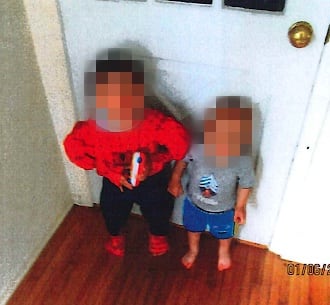WARNING: This story details allegations of child abuse.
A forensic pathologist has testified the autopsy he performed on a 12-year-old who was in the care of two Burlington, Ont., women was unable to determine the boy’s cause of death.
However, Dr. Michael Pickup said he could also not rule out possible causes of death, including hypothermia, or cardiac arrest linked to severe malnourishment.
Pickup, Ontario’s deputy chief forensic pathologist, testified Tuesday and Wednesday at the trial for Brandy Cooney and Becky Hamber, who’ve pleaded not guilty to first-degree murder of the boy and other counts.
The two were in the process of adopting the 12-year-old, known in court as L.L., when he died in 2022. The identities of L.L. and his younger brother, J.L., are protected under a publication ban.
Cooney and Hamber are also charged with confinement, assault with a weapon — namely zip ties — and failing to provide the necessaries of life to J.L.
The Ontario Superior Court judge-only trial began last month and is being heard by Justice Clayton Conlan in Milton. It is expected to continue into November.
Inquest report, step by step
Crown attorney Monica MacKenzie asked Pickup to go through his report on L.L.’s autopsy step by step and explain what he found.
Pickup said L.L.’s body did not have any evidence of “significant injury” or abnormalities.
The autopsy found L.L. had ingested 11 pills that tests determined to be Venlafaxine, a medication he was prescribed. According to Health Canada, the drug is used to treat depression, anxiety or nervousness, social anxiety and panic disorders.
Pickup said test results showed the concentration of that medication was higher than normal for therapeutic purposes, but not fatal.
He said given how thin and small L.L. was, malnutrition was “high on my list” as a possible cause of death.
Earlier in the trial, the court heard from an expert in child nutrition who testified that L.L. was 48 pounds before death, under what he weighed when he was six years old, and that he was severely malnourished when he died.
“There’s nothing that can prove that he died from malnutrition,” Pickup said Wednesday of his autopsy, with the caveat that he couldn’t reliably measure the electrolytes in L.L.’s blood when his heart stopped.
Pickup said malnutrition can lead to electrolyte imbalances that can affect the rhythm of one’s heart, potentially stopping it. He said that in this case, that could not be proven or excluded as a cause of death.
He also explained that proving acute starvation as a cause of death would require finding a high concentration of ketones — which are acids produced when a body breaks down fat for energy, instead of that energy coming from food.
Pickup said he did not find ketones in L.L.’s body, but their absence does not rule out the possibility of starvation. He said L.L. was so thin that his body wouldn’t have had much fat to digest.
Hypothermia cited as possible death cause
MacKenzie also asked Pickup about possible causes of death, including drowning, smothering and hypothermia.
Pickup said signs of any of those would be subtle, and he would need to know more about the scene and circumstances of one’s death to make such a finding.
MacKenzie then posed what she called “a hypothetical” question to Pickup that mirrored the Crown’s narrative of this case.
She asked: If a “chronically malnourished” 12-year-old who slept without a blanket started shivering, was warmed with water, then found by EMS in a puddle wearing a soaked-through wetsuit, could hypothermia have contributed to his death?
“It’s possible, yes,” Pickup responded.
According to the agreed statement of facts, on the night of Dec. 21, 2022, first responders attending to L.L. found him in a basement bedroom. He was soaking wet and in a puddle of an unknown liquid. A wetsuit had been cut off his body and was lying near a mesh cot — the only piece of furniture in the room.

The defence asked Pickup more about hypothermia and the state L.L. was found in.
Cooney’s lawyer, Kim Edward, asked Pickup what, if any, relevant clues he saw that could have indicated hypothermia.
The doctor said there were none beyond L.L.’s body temperature being very low in the hospital. He said he did not put much weight in that because he didn’t know when the measurement was taken relative to L.L.’s heart stopping.
Hamber’s lawyer, Monte MacGregor, asked why Pickup thought L.L. was all wet. The pathologist said he did not know, but it might have been because L.L. was dunked in water.
MacGregor said the pool of liquid was estimated at up to a litre and a half. He asked Pickup if it’s possible for a patient to urinate or defecate upon death. Pickup said that’s “not something we see very commonly.”
If you’re affected by this report, you can look for mental health support through resources in your province or territory .






